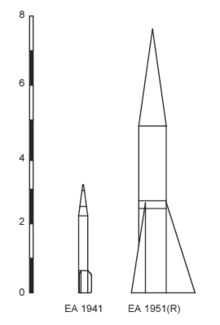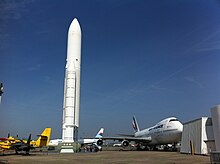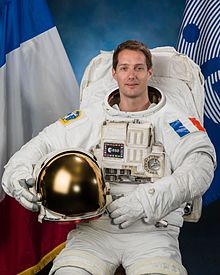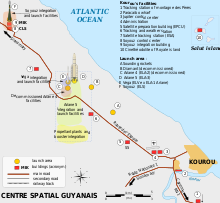This article has multiple issues. Please help improve it or discuss these issues on the talk page. (Learn how and when to remove these messages)
|
The French space program includes both civil and military spaceflight activities. It is the third oldest national space program in the world, after the Soviet (now Russian) and American space programs, and the largest space program in Europe.
Background

Space travel has long been a significant ambition in French culture. From the Gobelins' 1664 tapestry representing a space rocket, to Jules Verne's 1865 novel From the Earth to the Moon and George Méliès' 1902 film A Trip to the Moon, space and rocketry were present in French society long before the technological means appeared to allow the development of a space exploration program.
During the late 18th century, Jean-François Pilâtre de Rozier, Jacques Charles and the Montgolfier brothers are seen as worldwide precursors and explorers of aeronautics, with the world record altitude then reached by a human at 7,016 metres (23,018 ft) performed by Joseph-Louis Gay-Lussac in 1804. Those names, their numerous students and their works will mark the early expertise of France's space program in all types of air balloons since.
In the beginning of the twentieth century, the origins of the French space program are tied to French technological developments in aerospace and astronautics, notably the nascent airplane and rocket industries.

Robert Esnault-Pelterie appears as one of the early pioneers in space exploration design and rocket science. From 1908, he studied propulsion and space flight; without knowing the work of Russian mathematician Konstantin Tsiolkovsky at that time, he derived the mathematical equations for interplanetary flight, flight durations, and engine propulsion, and was later nominated President of the Chambre Syndicale des Industries Aéronautiques (Trade association of Aircraft industries) in 1912. From 1935 to 1939 he designed a high-altitude sounding rocket, but World War II interrupted his plans; German experts believed that the rocket could have reached its design goal of 60 miles (97 km). Esnault-Pelterie convinced physicist Jean-Jacques Barré, a pioneer in rocket propulsion, to collaborate on the design of a self-propelled cryogenic rocket. Between 1927 and 1933, Barré did extensive research and developed a rocket that could reach the upper atmosphere and space, the EA-41 Eole (see picture).
History
The beginning of the institutional French space program dates back to 1946 when, right after World War II, the Laboratoire de recherches balistiques et aérodynamiques (LRBA, Ballistic and aerodynamic research laboratory) was formed in Vernon to develop the next generation of rockets, partly taking advantage of the German development of the V2 rocket.
Before this and during the war, as Free France continued to work, the EA-41 was tested and improved by military personnel, from October 1942 through to 1945.
22 May 1952: Véronique N1 is successfully launched from the Saharan desert.
In 1958, President Charles de Gaulle directed the creation of several space research committees. In 1959, the Comité d'études spatiales was born under the supervision of Pierre Auger. In 1961, de Gaulle signed the creation of the Centre national d'études spatiales (CNES) to coordinate French space activities. Development of Western Europe's first carrier rocket, the Diamant, began in 1962, first launched in Algeria.
On November 26, 1965, Astérix, the first French satellite in space, is successfully launched by a Diamant rocket from the Algerian desert. It is active for 2 consecutive days before ceasing to transmit.
In 1965, France's space launch pads and CNES settled in Kourou.
In 1973, France drove the creation of the European Space Agency and became its first contributor.
The French space budget, although stagnant since the early 2000s in constant euros, remains in absolute terms the largest of the member countries of the European Space Agency (ESA) and the second largest national budget (after the United States of America) at €2.33 billion. In 2004, this budget stood at €1.698 billion, with €685 million being transferred to the Paris-based ESA for the programs conducted under its supervision.

The Ariane rocket family is France's own rocket family, whose use has been extended to the whole of ESA member countries.
Its spaceport, near Kourou, was selected in 1964 to host all of France's launches. Later, it was selected as ESA's launch site. Before being in French Guiana, France's space launches were made from Algeria, in Colomb-Béchar and Hammaguir.
The French space program thus benefits from the best ground position for launch sites on Earth, as its position 5.3° north of the equator allows rockets to gain propulsion from the spinning of the Earth when launched eastward (+460 m/s) and save on propellant. No other governmental launch sites allow this level of physical parameters. It is also able to launch satellites into polar orbits from this spaceport, although the rotational velocity becomes a penalty for Sun-Synchronous orbits.
Launch statistics
- As of 28 December 2024
As of 2017, Kourou counts amongst the spaceports with the highest percentage of successful launches, both successive and overall. Here is a chronology of all orbital launches from the Kourou spaceport since 1970, under the French and European space programmes.
Flights by launcher
3 6 9 12 15 1970 1975 1980 1985 1990 1995 2000 2005 2010 2015 2020 Active:Retired:
Flights by mission outcome
3 6 9 12 15 1970 1975 1980 1985 1990 1995 2000 2005 2010 2015 2020Success Failure Partial Failure Scheduled
- Charts include all orbital launches from Kourou; sounding rockets are excluded.
- Historical data: launch tables from List of Ariane launches, Soyuz ST, Vega and Encyclopedia Aeronautica.
Collaborations

France's public involvement in space technologies is also deep into European programs such as Columbus (Thales Alenia Space) or Automated Transfer Vehicle (Airbus Defence and Space).
The French space program includes collaborations between its institutions and other countries, European as well as other foreign countries and institutions (JAXA, ISRO, NASA, CNSA) in projects ranging from the Herschel Space Observatory to BepiColombo, Saral/Altika and the Planck space observatory.
Since 2010, France and Russia have been collaborating on several space missions, including long-run science programmes like Cardiomed, dedicated to monitoring cardiovascular health in cosmonauts.
In 2016, for the COP21, CNES and ISRO impulsed a groundbreaking and worldwide plan to unite all space agencies for the gathering of satellite information and detection on greenhouse gas emissions, allowing more precise measurements and decision making. In addition, CNES and ESA have a strong background of collaboration, notably building the largest single satellite surveyance program for earth's biological monitoring (Copernicus Programme).
CNES has provided essential instruments (cameras) on an Indian mission to the Moon (Chandrayaan-1), launched in January 2018. A consortium led by the CNES also built Argos instruments on board India's Oceansat-3 in 2018. A third collaboration between the ISRO and French space actors (LESIA, CNRS, Université Paris-VI and Université Paris-VII) has seen the launch of PicSat in January 2018, a nano-satellite that surveys the Beta Pictoris star for exoplanets.
The French space agency was also responsible for the construction of the main instruments on the French-German-American InSight mission to Mars, which launched on 5 May 2018 and landed on 26 November 2018.
On 20 October 2018, CNES and JAXA launched the BepiColombo mission to study the magnetic field of Mercury and map its surface.
On 29 October 2018, the CFOSAT [fr] (China-France Oceanography SATellite) was placed into Earth orbit to study ocean surface winds and waves. After President Macron's state visit to China in January 2018, the French-Chinese collaboration in space was increased significantly and includes more in-depth collaboration, notably in the sharing of CFOSAT data, meant to study oceans and their interaction with the atmosphere, as well as in the SVOM program.
In 2020, Solar Orbiter was launched by NASA, containing instruments designed by CNES and other French industrial actors.
The French satellite TARANIS, with international collaboration, was launched in November 2020. The launch was a failure (of the launching rocket) and the satellite never entered use. It would have been the 1st satellite designed to observe lightning at altitudes of 20 to 100 km.
Future projects
| This section needs to be updated. Please help update this article to reflect recent events or newly available information. (January 2019) |
The construction of the Ariane 6 launcher, after being approved by all ESA countries in 2016 was completed with its inaugural flight that took place on 9 July 2024. It is designed by Airbus Safran Launchers.
2023 will mark the launch of Jupiter Icy Moons Explorer. It will study Jupiter and three of its moons with a view to gaining new insights into how life emerged. This mission is a collaboration of CNES with CNRS and ESA.
In 2025, France and Germany will launch their collaborative mission Merlin, due to study methane levels and concentrations in the Earth's atmosphere.
See also

- People
- Companies and organisations
- CNES
- European Space Agency
- Airbus
- Safran
- Arianespace
- ArianeGroup
- Astrium
- Thales Group
- Thales Alenia Space
- Aérospatiale
- Dassault
- ISAE-SUPAERO
- École nationale supérieure de mécanique et d'aérotechnique (ISAE-ENSMA)
- École nationale supérieure d'ingénieurs de Poitiers
- École nationale de l'aviation civile
- France AEROTECH
- École nationale supérieure d’électronique, informatique, télécommunications, mathématique et mécanique de Bordeaux
- French Air and Space Force

- Locations
- More
- Félicette, the only cat in space
References
- Jean Cheymol. "Astronautique" (PDF). Biusante.parisdescartes.fr. Archived from the original (PDF) on 2019-04-26. Retrieved 2017-08-11.
- Larousse, Éditions. "Encyclopédie Larousse en ligne - Robert Esnault-Pelterie". Larousse.fr. Retrieved 11 August 2017.
- Ley, Willy (June 1964). "Anyone Else for Space?". For Your Information. Galaxy Science Fiction. pp. 110–128.
- Jacques Villain, 1993 : Jean-Jacques Barré pionnier français des fusées et de l'astronautique SEP, 1993
- ^ "Chronologie Ariane". Capcom Espace (in French). Retrieved 6 February 2017.
- "Le 2ème budget au monde". cnes.fr. 24 April 2015. Retrieved 11 August 2017.
- "Choix de la Guyane - CNES". Cnes-csg.fr. Retrieved 11 August 2017.
- Clark, Stephen (26 October 2018). "Launch schedule". Spaceflight Now. Retrieved 28 October 2018.
- "Le Centre Spatial Guyanais - CNES". cnes-csg.fr.
- "cnes - Bibliothèque des projets du CNES". cnes.fr. Retrieved 11 August 2017.
- "Cardiomed". 24 April 2015.
- "World's space agencies unite to face the climate challenge". cnes.fr. 3 June 2016. Retrieved 11 August 2017.
- "Coopération spatiale entre la France et l'Inde" (in French). Télé Satellite et Numérique. 12 January 2017. Retrieved 2 February 2017.
- "France-India space cooperation – CNES and ISRO review joint projects at Bengaluru Space Expo 2016" (Press release) (in French). CNES. 1 September 2016. Retrieved 2 February 2017.
- "Un nanosatellite à l'affût d'une exoplanète". Le Monde.fr. 9 January 2018.
- Barbosa, Rui C. (28 October 2018). "Long March 2C lofts CFOSAT for CNES". NASASpaceflight. Retrieved 2 October 2020.
- "Visite d'Etat du Président de la République en République Populaire de Chine : Renforcement de la coopération spatiale franco-chinoise dans les domaines du climat et de l'exploration". 10 January 2018.
- "Solar Orbiter" (in French). CNES. 24 April 2015. Retrieved 2 February 2017.
- "Taranis". CNES. 24 April 2015. Retrieved 2 February 2017.
- de Selding, Peter B. (2 December 2014). "ESA Members Agree To Build Ariane 6, Fund Station Through 2017". SpaceNews. Retrieved 2 February 2017.
- de Selding, Peter B. (3 April 2015). "Desire for Competitive Ariane 6 Nudges ESA Toward Compromise in Funding Dispute with Contractor". SpaceNews. Retrieved 2 February 2017.
- "Juice" (in French). CNES. 24 April 2015. Retrieved 2 February 2017.
- "FBH lidar diodes promise clearer view of climate change – Franco-German Merlin satellite measuring atmospheric methane to be launched in 2025". SPIE. 20 July 2020. Retrieved 2 October 2020.
- "Merlin" (in French). CNES. 24 April 2015. Retrieved 2 February 2017.
External links
| Public-sector space agencies | |||||||||||||
|---|---|---|---|---|---|---|---|---|---|---|---|---|---|
| Africa |
| ||||||||||||
| Americas |
| ||||||||||||
| Asia |
| ||||||||||||
| Europe |
| ||||||||||||
| Oceania | |||||||||||||
| World | |||||||||||||
| Former | |||||||||||||
| |||||||||||||
| Public-sector space agencies | |||||||||||||
|---|---|---|---|---|---|---|---|---|---|---|---|---|---|
| Africa |
| ||||||||||||
| Americas |
| ||||||||||||
| Asia |
| ||||||||||||
| Europe |
| ||||||||||||
| Oceania | |||||||||||||
| World | |||||||||||||
| Former | |||||||||||||
| |||||||||||||
Portals: Category: